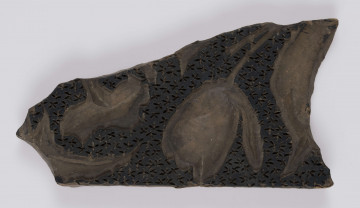
Block for printing on textile
1901 — 1950
National Museum in Lublin
Part of the collection: Fabric printing matrices
In 19th-century Pomeranian towns, many local dye shops specialised in textile printing. The local communities eagerly purchased their products, which were not only considered to be durable and practical but were also treated as a substitute for the expensive, fine fabrics that only few could afford. Roman Reinfuss, ethnographer, characterizing the Pomeranian textile printing stamps wrote: “(...) we see a significant influence of style textiles and non-folk prints. Next to the stamps coming from non-folk 18th-century textile printing, there are also the 19th-century stamps with small floral designs placed in a checkerboard or straight lines”. An example of a stamp with such a design is the one from the collection of the Pommersches Landesmuseum Stettin with a pattern consisting of small flowers with heart-shaped leaves placed in fields of a grid, formed by lines carved diagonally to the edge of the stamp. The ornament is partially carved in wood and partially made with nailed brass pins and plates. Printed fabrics were highly popular among rural communities, but they were displaced by the products of the modern textile industry. At the beginning of the 20th century in Pomerania, one could still encounter local dye shops, but with the Second World War, the hand textile printing was brought to an end.
Author / creator
Dimensions
cały obiekt: height: 3,6 cm, width: 18,8 cm
Object type
matrix
Creation time / dating
Creation / finding place
Identification number
Location / status

1901 — 1950
National Museum in Lublin

1901 — 1950
National Museum in Lublin

1901 — 1950
National Museum in Lublin
DISCOVER this TOPIC
National Museum in Lublin
DISCOVER this PATH
Educational path